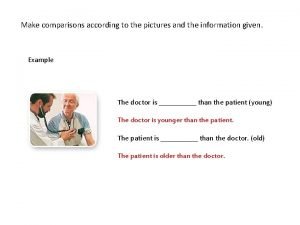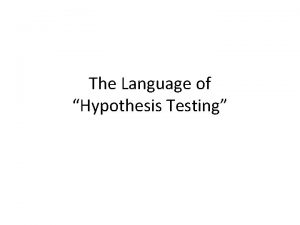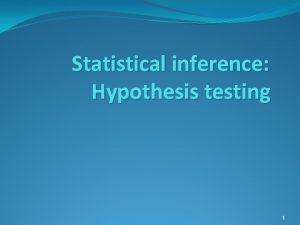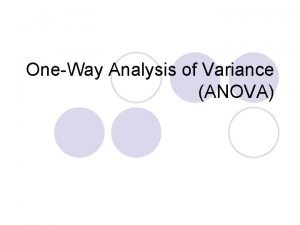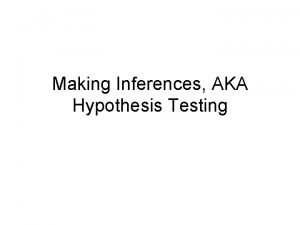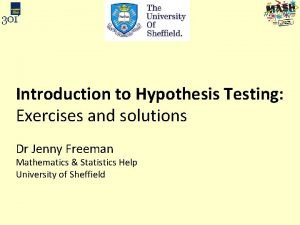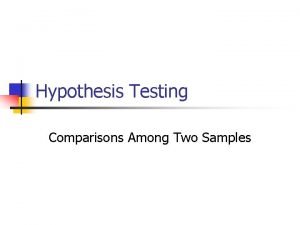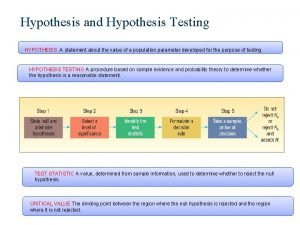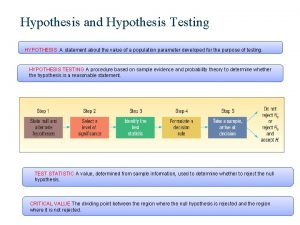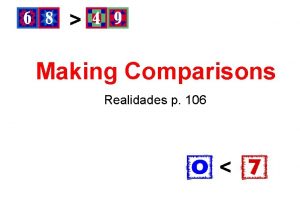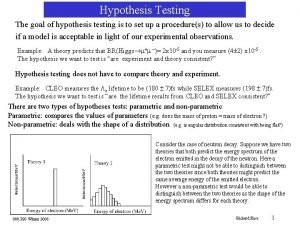Making Comparisons All hypothesis testing follows a common













- Slides: 13

Making Comparisons • All hypothesis testing follows a common logic of comparison • Null hypothesis and alternative hypothesis – mutually exclusive – exhaustive • “Republicans have higher income than Democrats”? – Descriptive, relational, and causal

Experimental Design • Draw a random sample • Manipulate the independent variable through treatment or intervention • Random assignment into experimental and control groups • Control (keep constant) other outside factors • Observe the effect on the dependent variable

Methods of Making Comparisons Independent Variable Categorical measures (nominal or ordinal) Continuous measures (interval or ratio) Categorical Cross-Tabulation measures (Chapter 10) & (Chapter 7) Chi(nominal or Logistic Regression square ordinal) Dependent Variable Continuous Compare Means & (Chapter 8) measures (Chapter 9) Correlation & (interval or Dummy Variables Linear Regression ratio)

Inferences about Sample Means • Hypothesis testing is an inferential process • Using limited information to reach a general conclusion • Observable evidence from the sample data • Unobservable fact about the population • Formulate a specific, testable research hypothesis about the population

Null Hypothesis • no effect, no difference, no change, no relationship, no pattern, no … • any pattern in the sample data is due to random sampling error

Errors in Hypothesis Testing • Type I Error – A researcher finds evidence for a significant result when, in fact, there is no effect (no relationship) in the population. – The researcher has, by chance, selected an extreme sample that appears to show the existence of an effect when there is none. – The p-value identifies the probability of a Type I error.

Cross-tabulation • Relationship between two (or more) variables – Joint frequency distribution – Contingency table • Observations should be independent of each other – One person’s response should tell us nothing about another person’s response • Mutually exclusive and exhaustive categories

Cross-tabulation • If the null hypothesis is true, the independent variable has no effect on the dependent variable • The expected frequency for each cell Male Female Total Pro- ? ? 2 Anti- ? ? 8 Total 5 5 10

Expected Frequency of Each Cell • Expected frequency in the ith row and the jth column ……… (Eij) • Total counts in the ith row ……… (Ti) • Total counts in the jth column ……… (Tj) • Total counts in the table ……… (N)

• Observed frequencies: Male Female Total Pro- 0 2 2 Anti- 5 3 8 Total 5 5 10 Male Female Total Pro- 1 1 2 Anti- 4 4 8 Total 5 5 10 • Expected frequencies:

Chi-square (X 2) • For each cell, calculate: • (observed frequency - expected frequency)2 expected frequency • Add up the results from all the cells

Cross-Tabulation Independent Variable Nominal measures Lambda Cramer’s V gamma Lambda Kendall’s tau-b Ordinal measures Cramer’s V Kendall’s tau-c Somer’s d Nominal measures Dependent Variable Lambda Cramer’s V Ordinal measures

Measures of Association • Symmetrical measures of association – e. g. Kendall’s tau-b and tau-c • Asymmetrical measures of association – e. g. lambda and Somer’s d • Directional measures of association – e. g. Somer’s d • PRE measures of association – e. g. lambda and Somer’s d
 Difficult comparative degree
Difficult comparative degree Pictures to make comparisons
Pictures to make comparisons Realidades 2 capitulo 1b making comparisons
Realidades 2 capitulo 1b making comparisons Realidades 2 capitulo 1b making comparisons answers
Realidades 2 capitulo 1b making comparisons answers Hypothesis testing in research example
Hypothesis testing in research example Null hypothesis vs alternative hypothesis
Null hypothesis vs alternative hypothesis Examples of null hypothesis
Examples of null hypothesis Protoplanet hypothesis weakness
Protoplanet hypothesis weakness Name all the rays
Name all the rays The language of hypothesis testing
The language of hypothesis testing P-value interpretation
P-value interpretation One way anova null hypothesis
One way anova null hypothesis Hypothesis testing assignment
Hypothesis testing assignment Hypothesis testing
Hypothesis testing

